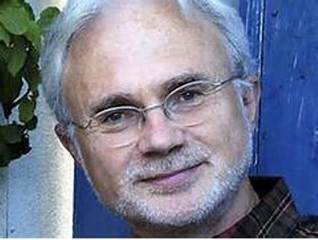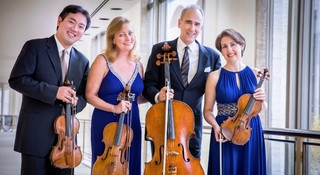|
Back
Forte, Fortissimo, Fortissimum New York
David Geffen Hall, Lincoln Center
03/09/2017 - & March 10, 11, 2017
John Adams: Absolute Jest – Harmonielehre
New York Philharmonic String Quartet: Frank Huang, Sheryl Staples (Violins), Cynthia Phelps (Viola), Carter Brey (Cello)
New York Philharmonic Orchestra, Alan Gilbert (Musical Director/Conductor)

J. Adams (© NPR.org)
How does one possibly describe John Adams in a mere 800 words? For hours, I’ve been ruminating on his algo-rhythmic gamesmanship, his eclectic knowledge (from Medieval mythology to Carl Jung to never-correct political sagacity) to his most prolific New England diligence and his San Francisco exoticism, to his wondrous dramatic settings with Alice Goodman and Peter Sellars.
In desperation, I called up a scholar who writes Chinese history books and happens to love the composer. And forced her to describe his impact on her.
“John Adams?” she said. “Is he a human? I thought he was bolt of electricity. I never considered him a composer, I always thought somebody would send an inter-planetary signal to his brain, and a combination of lightning bolts and quicksilver would come out of him.
“And then we’d listen to the result.”
Considering that my friend can’t read music, she kind of hit it. And last night, the two massive orchestral works, in honor of his 70th birthday, made the usual reticent eaves of David Geffen Hall resound with massive antiphonal sounds.
Mr. Adams was on the stage with Conductor Alan Gilbert, the New York Philharmonic, and the newly formed New York Philharmonic Quartet, where he attempted an explanation of his first work, Absolute Jest. Yes, we easily understood that this was not a “jest” (any more than a Beethoven scherzo is a “joke”), and that he had taken parts of Beethoven string quartets (demonstrated “straight” by the NY Phil Quartet), and processed them into a one-movement 26-minute work.

NY Philharmonic String Quartet (© New York Philharmonic)
But not until the performance did one realize how Absolute Jest became such a massive, entertaining, Titanic homage to Beethoven himself. Not that this is a Beethoven pastiche in the usual way. Everybody from Schumann to Liszt to Mauricio Kagel has taken Beethoven themes and used them in their personal ways. But John Adams was different.
That quicksilver mind of John Adams both quoted from and yes, reprocessed the music, so inspirations became amalgamations. It was easy to recognize the themes from Opus 135, from the Grosse Fuge and–with those three-note-timpani tattoos–the scherzo from the Ninth Symphony. But John Adams wasn’t satisfied with that.
Instead, he used the string quartet not as in a concerto grosso, but with grand solos (I counted two four-person cadenzas, but there could have been more). On the YouTube recording, it was difficult to separate the two ensembles, but here, those players–the four first-chair string players of the Phil–took their difficult parts with an easy, even genteel adoration.
Admittedly, listening non-stop to Absolute Jest was an exciting experience. But the 26-odd minutes of countless equations around Beethoven could have become wearying. Mr. Adams gave us far too much in far too short a time. We were listening to a marathon of notes, both familiar and eccentric, all baked into a single dessert.
The saving grace was Maestro Gilbert, who stood apart from the aggregation of sounds. His link with the Phil is now instinctive. And the orchestra itself is now so attuned to the most difficult music, that the work achieved, in spite of the monumental forces, a kind of cerebral transparency.
Absolute Jest, though, was pablum compared to the 42-minute Harmonielehre, the title of Arnold Schoenberg’s treatise on composition. Not that Adams is a Schoenbergian. His connection with the atonalist is, to say the least, complicated. But such complexities are caviar for the John Adams medullae. And this three-movement work was a shattering revelations of...
Of what?. His own program notes were scintillating, but gave no clue of the Zeus-powered music that was to come. Which started with about 15 minutes of drum-hitting, full orchestra-playing in a non-stop forte fortissimo gang-bang of music.
(Having gone to most of the Bruckner symphonies two weeks ago, I realized that next to John Adams, the most grandiose Bruckner climaxes would sound like Georg Philipp Telemann Blockflöte trios.)
Mr. Adams was hinting at a reprocessing of Schoenberg’s Guerrelieder here–albeit with a middle section which swooned with Late Romantic melody. The second movement, taken from the Medieval mythology of the man who kept the Holy Grail, was more mystical, an opaque homage to Sibelius, to Mahler, to...well, to John Adams at his purely most elegiac. Augmented by a lone trumpet solo, akin to Ives’ Unanswered Question but more complex in the orchestra.
The third movement was named “Meister Eckhardt and Quackie”, another medieval mystical figure, and his baby daughter, nicknamed “Quackie”. It was inspired by a dream (as are other Adams movements), was again a smashing orchestral extended fanfare–but that came after a lullaby. Perhaps not a lullaby that would have consoled young Quackie, but the ideal coda to the second movement. After that, we were in tumultuous territory. Velocity, amplitude, brass, percussion and that John Adams melange of gossamer, delicate, finespun ferocious exaltation.
CODA: It ain’t all ferocity. Some of Adams’ string quartets will be performed at National Sawdust on April 2 by the aptly named Attaca String Quartet. See you there.
Harry Rolnick
|